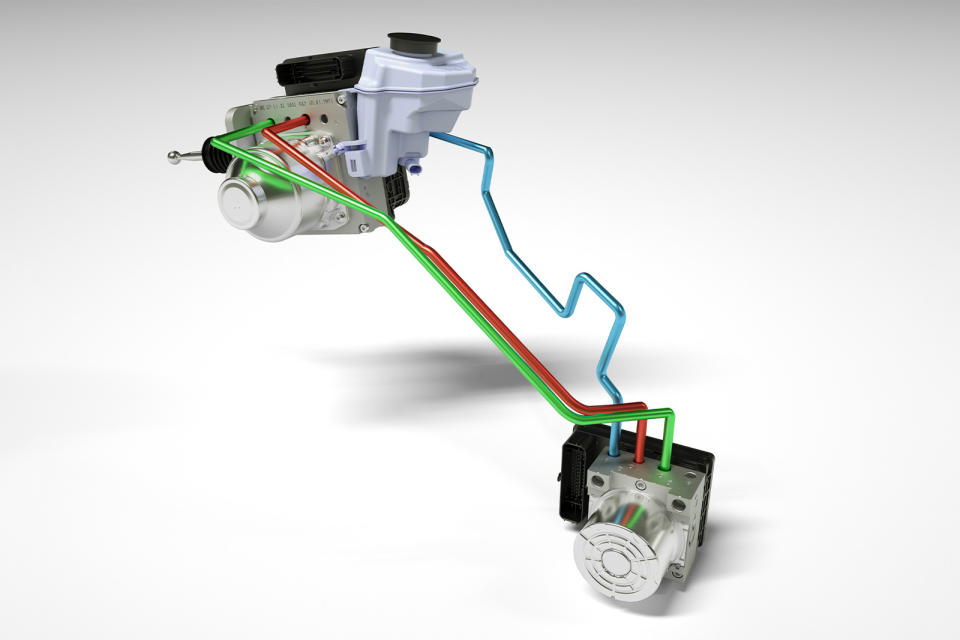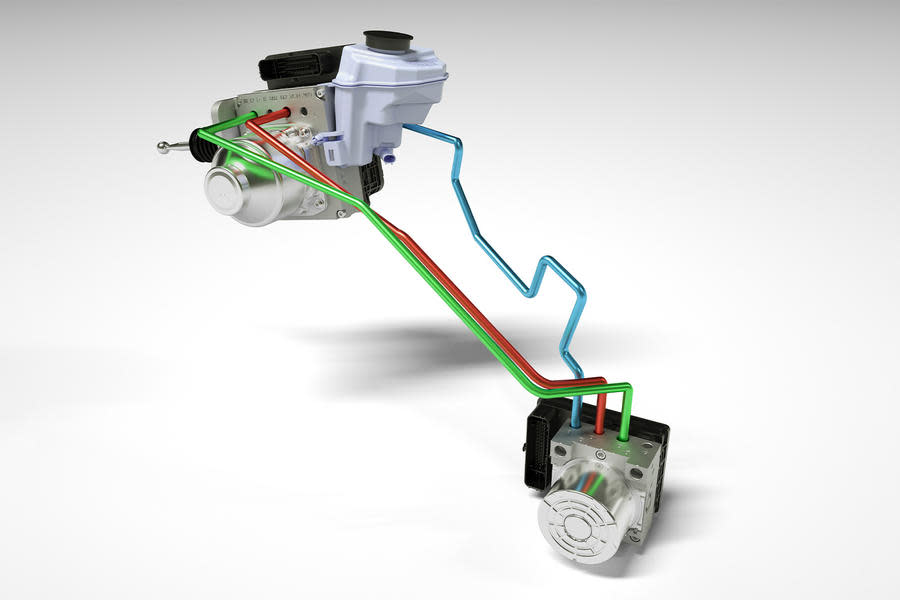What is brake-by-wire and how does it work?

Continental's MK C2 brake system architecture
Beneath their often wildly futuristic bodies, today’s cars host technology that hasn’t changed much since the very early days - but manufacturers are seeking to change that with brake-by-wire systems.
Braking systems are an example of technology that has stayed largely the same for years: although not widely adopted until a little later, hydraulic brakes have been around since the turn of the 20th century. So: what is a brake-by-wire system?
What is a brake-by-wire system?
A brake-by-wire system controls the brakes of their car through the use of electricity, rather than a traditional hydraulic system. There is no mechanical connection between the driver and the car.
The idea was that electric calipers would do the braking and electric steering racks would enable fancy features such as enabling the car to take major avoiding action in emergency situations without ripping the driver’s thumbs off on the steering wheel spokes.
Ditching hydraulics and cleaning up and simplifying brake systems by moving to electronic actuation (so-called brake-by-wire) has been discussed for years, and there have been plenty of prototypes.

The first step towards it happening for real was Continental’s MKC1 system, which made its debut in 2018 on the Alfa Romeo Giulia and Alfa Romeo Stelvio, but that was just the beginning of the company’s plans for what it calls Future Brake Systems (FBS), which will lead to complete brake-by-wire systems.
The MKC1 system goes part of the way to full brake-by-wire but stops short of electric brake calipers. What it does do is integrate the tandem master brake cylinder (which generates the hydraulic pressure to apply the brakes), the brake booster, the ABS unit and the ESC unit, saving about 4kg.
Brake-by-wire systems for parking brakes
Electronic parking brakes have used a developed version of brake-by-wire, which removed the need for a traditional cable-operated system and a handbrake lever.
Modern cars are now fitted with electronic systems that can automatically release when moving off, or assist a car when temporarily stopped on an incline, called ‘hold assist’.
How does a brake-by-wire system work?
Brake-by-wire systems control the brakes using electricity, employing a sensor to monitor how forcefully a driver has pushed down on the brake pedal.
The system’s control unit then sends a message to an electric pump to produce the desired amount of pressure to slow down the car, or bring it to a complete stop.
Continental’s plan has four levels, with 'FBS 0-3' the long-term objective. The firm has already developed its MKC1 system into MKC2, which sits at level FBS 0. This combines the brake master cylinder, ABS and ESC into one unit, rather than the driver’s foot being linked directly to a hydraulic cylinder.

It combines the brake master cylinder, ABS and ESC into one unit, and rather than the driver’s foot being linked directly to a hydraulic cylinder via the brake pedal, it’s working a sensor instead. Hydraulics are still involved, but a pump generates the pressure to apply the brakes.
FBS 1 will get rid of the sizeable unit mounted near the driver’s feet on the car’s firewall and replace it with an electronic pedal, freeing up space, but beyond that the brakes will still be ‘wet’.
FBS 2 will be ‘semi-dry’ or ‘dry on one axle’, meaning the front brake calipers will still be actuated by hydraulics while the rears become electromechanical. Continental says its customers are interested in this as a first step.
The full monty will be FBS 3, where hydraulics are gone, with a fully ‘dry’ system being electronically controlled and electrically actuated. Continental says that will decentralise the braking system, enabling vehicle architectures to use space more effectively.
FBS 2 is already a reality. It will enter production with an American maker in 2025.
Advantages of brake-by-wire
Brake-by-wire systems are intuitive and there are several benefits over a mechanical braking system.
Aside from the packaging and weight, pedal feel can be tuned by engineers using driving simulators to give a more aggressive response on track and a more relaxed response in traffic.
Another advantage is that pedal travel doesn’t increase when the brakes take a beating and get hot. What the driver actually feels is a simulator built into the MKC1 that generates the sensation normally fed back through the hydraulics, only it remains consistent however hard the brakes are working.
Full drive-by-wire wire brakes would also allow manufacturers to dispense with that nasty, inflammable, corrosive material that is hydraulic brake fluid, giving them dry chassis and production lines that have no need for the messy liquid.
Complete corners consisting of suspension, wheel hubs, discs and brakes could be preassembled ready to bolt on the car. A further advantage of doing away with hydraulic brake fluid is that it’s hygroscopic (it absorbs atmospheric moisture) so needs changing at intervals.
It will also mean that brake systems, like the modern vehicle architectures to which they are fitted, can become modular and distributed throughout the car.
Steer-by-wire systems
What about steer-by-wire? Although electric power-assisted steering (EPAS) is common now, mainly because it’s far less energy-hungry than a hydraulic steering pump, it still maintains a mechanical connection between driver and steering; it just takes away some of the steering effort from the driver by using a motor.
Full steer-by-wire would mean decoupling the driver from the steering gear altogether and that would require a change in legislation.
Although complete brake-by-wire and steer-by-wire haven’t yet made production, another form of full drive-by-wire tech has been around for a while.
Electronic throttles have no mechanical connection between the accelerator pedal and the engine’s throttle. Instead, an array of sensors on the pedal box and engine pass the information the engine computer needs to adjust the throttle and the amount of fuel injected.
What’s the point? Mainly to help control fuel consumption and therefore emissions.
Both brake-by-wire and steer-by-wire have made it to the prototype stage and will reach public roads eventually. Indeed, they will have to if driverless autonomous cars are to become a reality. But, for now, both are consigned to the back-burner.
]]>

 Yahoo Autos
Yahoo Autos